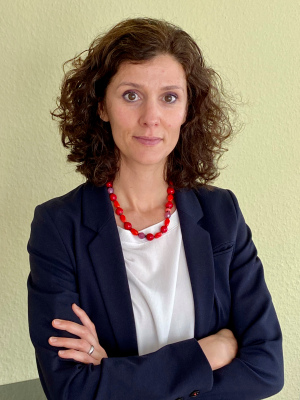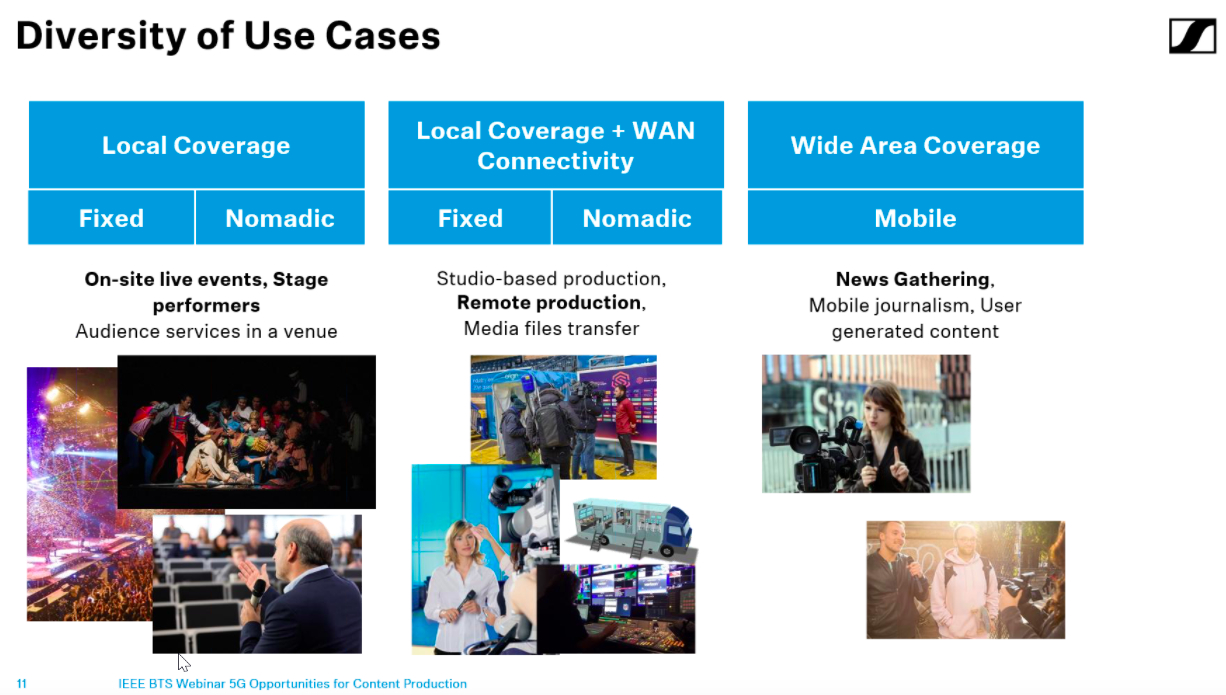5G has the potential to become a key part of workflows in the live content production space, including for electronic newsgathering (ENG), live events with stage performances, various forms of remote production, and user-generated content.
Specifically, the use cases for 5G technology in content production could include local coverage for fixed or nomadic applications (on-site live events, stage performers, audience services in a venue); local fixed or nomadic coverage plus WAN connectivity (studio-based production, remote production, media file transfer); and wide area mobile coverage (news gathering, mobile journalism and user generated content).
The first category here is often referred to as PMSE: Program Making and Special Events, describing radio applications used for broadcasting, newsgathering, theatrical productions and special events and applications used in meetings, conferences, local entertainment, sport, religious and other events for real-time presentation of audio-visual information.
Currently, electronic news gathering (ENG) relies on a mix of DVB-T (UHF) links, satellite and bonded cellular (single-source contribution) from the reporter in the field via an OB van or field unit back to the production facility.
“There is a long way to go and a lot of work to do before 5G can really be adopted by the content production sector.”
DR.-ING. MARIA DOLORES (LOLA) PÉREZ GUIRAO, SPECTRUM & INNOVATION MANAGER, RESEARCH & INNOVATION, SENNHEISER
In the case of remote production from a venue or stadium, currently audio, video and service are segmented and sent via an OB van on-site to the production facility via a mix of WAN connectivity — satellite links, leased fibre lines and microwave links. Features of this current model include diverse AV networking standards, different frequency bands, vendor-specific solutions and limited interoperability.
In each of the conventional production scenarios outlined, requirements include very low latency for live performers, accurate synchronization between streams, the high reliability critical for live performances, uplink capacity for multi-camera contribution, and low power consumption.

These topics were outlined in an IEE Broadcast Technology Society (BTS) virtual event by Dr.-Ing., Maria Dolores (Lola) Pérez Guirao, Spectrum & Innovation Manager, Research & Innovation at Sennheiser. The title of the IEEE BTS session was “5G Opportunities for Content Production.”
In her presentation, Dr. Pérez Guirao summarized work conducted over the past two and a half years within 3GPP, EBU, and 5G-MAG working groups across the development of 5G technology for content production.
She discussed content production use cases and their potential requirements for 5G. Although most of the use cases discussed are already possible with existing technologies, they may see a successive migration to 5G as far as it is able to provide an added value (for example cost reduction, simplification of workflows and interoperability) to involved stakeholders. Further use cases that may be first enabled by 5G were also discussed.
IP-Based Workflows and Cloud-Based Distributed Production
“A key aspect is the situation regarding spectrum — what I call the spectrum squeeze,” said Pérez Guirao. “The amount of UHF band, which is the core band for broadcasters and PMSE use, has for years been under threat from the telco industry and has been almost halved in the last ten years.
“What about the future of live use-case content production? I have motivated this presentation with the thought that 5G offers an ultra-reliable low latency communication profile that targets latencies below one millisecond for the radio part so this is why we look at this technology and it could bring benefits.
“We have to think about how to integrate this technology and if it is really going to be able to fulfil its promise. What we see as a great advantage in the future is if we can get a kind of convergence of technology across the on-site and live PMSE applications involved in production — service, audio and video links — and also convergence across the production and distribution part of the media industry,” she said.

“For the ENG use case uplink capacity is critical and we really want to move away from the way it is done today, with cellular bonding and requiring several SIM cards and having contracts in different countries with different mobile network operators. It would be nice if electronic news gathering could be offered as a service by a 5G network, and nice if this could be offered across countries, making use of the roaming features and so on.
“Regarding remote production, we have experienced in the recent past an increasing shift towards IP-based workflows. This shift will continue independent of 5G: it is a shift away from specialized hardware and solutions to multi-tenant software solutions, flexibility in workflows and with the wish and expectation to be cost effective and reduce costs. We think the different facilities and elements of live content production can be connected to a flexible transport technology based on IP convergence.
“In the areas of IP-based workflows and cloud-based distributed production I believe 5G fits very well in the development process and improvement. 5G is an enabler for future content production — more than that it is accelerating the shift with an opportunity to enable the convergence and automation of workflows across content production, contribution and distribution in the media industry.
“This can help to get much-desired economies of scale and can bring cost reductions. Also, 5G is a moving target; the technology is always improving. So it has the potential to help develop in new applications, services and business models within the content production sector,” said Pérez Guirao.
Desire for Everything to be Compatible with Everything Else
Possible benefits of future on-site live and remote content production which includes 5G technology could include the convergence of production and distribution networks, with less interfacing and simplification of set-ups. 5G for remote production can help enable wireless WANs and cloud services for computing and storage, along with live audience and device services for content consumption.
Specifically for ENG, 5G could aid in news contribution performance from any location around the world, with ubiquitous infrastructure availability as a service along with uplink capacity.
There is also the ongoing shift towards IP-based workflows to consider. In combination with 5G this could enable the integration of PMSE equipment into one converged production based on IP connectivity, with flexible transport technology, fulfilling the desire of content producers for everything to be compatible with everything else, and to play directly with each other.

This combination also increases opportunities for distributed remote production, where the definition of “OB van” and “production facility” become somewhat blurred due to the flexibility to locate facilities and equipment pods in various places. Cost-reduction and increased flexibility could ensue, with a migration away from physical purpose-built facilities to virtual and cloud-based implementations at the edge.
Requirements for future content production will include QoS (across latency, synchronicity, reliability, capacity and spectral efficiency); on-demand/ad hoc deployments; portable nomadic dedicated network deployments with short set-up times; and automation of processes and workflows.
Commercially, access to existing UHF spectrum and local licensed spectrum must be maintained, said Pérez Guirao, along with technology convergence along the media value chain and also with other vertical industries.
“5G is an enabler for future content production — more than that it is accelerating the shift with an opportunity to enable the convergence and automation of workflows across content production, contribution and distribution in the media industry.”
DR.-ING. MARIA DOLORES (LOLA) PÉREZ GUIRAO, SPECTRUM & INNOVATION MANAGER, RESEARCH & INNOVATION, SENNHEISER
“There is a long way to go and a lot of work to do before 5G can really be adopted by the content production sector — and 5G needs to adapt to the technical, operational and commercial requirements of this sector.
“One thing that differentiates content production very much from other verticals is that we require ad hoc deployments on demand, for concerts and other event cases. We need to have network deployments that you can put in a truck or in a box and take with you.
“It has to be that deployments can be set up quickly with an increase in the automation and processes of the workflows but keeping the control over those workflows. We need to be able to monitor the operation of the event at any time during the performance,” she said.
“On the commercial side we want to have this technology convergence of the media value chain with all these other verticals and integration of the workflows. We need to keep access to our existing workflows and existing UHF spectrum, and we need additional spectrum in that local and temporary way for the requirements of our on-demand and ad hoc network deployments.”


